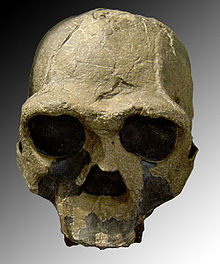Homo Ergaster
|
Homo ergaster Temporal range: 1.9–1.3 Ma Early |
|
|---|---|
 |
|
| Skull KNM-ER 3733, discovered by Bernard Ngeneo, 1975. (Kenya) | |
| Scientific classification | |
| Kingdom: | Animalia |
| Phylum: | Chordata |
| Class: | Mammalia |
| Order: | Primates |
| Suborder: | Haplorhini |
| Family: | Hominidae |
| Genus: | Homo |
| Species: | †H. ergaster |
| Binomial name | |
|
Homo ergaster Groves and Mazák, 1975 |
|
Homo ergaster (meaning "working man") or African Homo erectus is an extinct chronospecies of the genus Homo that lived in eastern and southern Africa during the early , that is, between 1.9 million and 1.4 million years ago. It is one of the earliest hominins, which are those hominids that comprise the original members and species of the human clade after splitting from the line of the chimpanzees. Homo ergaster is variously thought to be ancestral to, or as sharing a common ancestor with, or as being the same species as, Homo erectus.
Interpreting Homo ergaster inevitably leads to Homo erectus, particularly regarding the taxonomy issues that persist within the scientific community of classifying the two species and separating their two lineages—if indeed they represent two separate lineages rather than one. Some palaeoanthropologists consider H. ergaster to be a variety of H. erectus, that is, the so-called African Homo erectus. Others call H. ergaster the direct ancestor of H. erectus, which then emigrated out of Africa into Eurasia and branched into a distinct species. Still others dispense with the specific epithet ergaster and make no such distinctions among fossils assigned to erectus.
The latest discoveries at Dmanisi, Georgia, suggest that all the contemporary groups of early Homo in Africa, including Homo ergaster, are of the same species and should be assigned to Homo erectus.
The binomial name was published in 1975 by Groves and Mazák. The specific epithet, "ergaster", is derived from the Ancient Greek ἐργαστήρ "workman", in reference to the advanced lithic technology developed by the species, thereby introducing the Acheulean industry.
South African palaeontologist John T. Robinson discovered in 1949 a mandible of a new hominin in southern Africa, which he named Telanthropus capensis and which today is classified as Homo ergaster. That taxon was first applied to a mandible found near Lake Rudolf (now Lake Turkana), Kenya, by Colin Groves and Vratislav Mazák in 1975; dubbed KNM-ER 992, it became the type-specimen of the species. A near-complete skeleton of H. ergaster, KNM-WT 15000, or "Turkana Boy", was discovered in 1984 at Lake Turkana by Kamoya Kimeu and Alan Walker. It is dated to 1.6 million years ago (mya) and is one of the most complete early hominin fossils found to date.
...
Wikipedia
